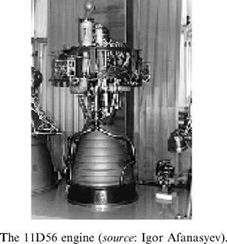Introducing liquid hydrogen
Glushko’s initial position was to use only hydrocarbon fuels in the RLA family and introduce liquid hydrogen (LH2) at a later stage, when the technology was ripe.
Glushko had always disliked liquid hydrogen. In the 1960s he had opposed the use of liquid hydrogen on the upper stages of the N-1 rocket, arguing that the low density of hydrogen required large tanks and worsened the rocket’s mass characteristics. At an August 1974 meeting where Glushko outlined his plans for the RLA rocket family, several participants urged him to move to liquid hydrogen straightaway, but Glushko remained adamant [38]. At another meeting he reportedly said:
“The person who can find a way of building a rocket suited for the orbiter but
with the use of oxygen-kerosene will become my deputy’’ [39].
However, by the end of the year Glushko had to yield to the pressure. On 30 November 1974 MOM minister Sergey Afanasyev signed an order to start the development of powerful cryogenic engines [40].
Despite Glushko’s wariness, Energomash had already performed some initial research on LOX/LH2 engines. In 1967 Glushko had tabled a proposal for a 200 to 250-ton cryogenic engine for the N-1 and a similar proposal had come from the Kuznetsov bureau [41]. Then there were studies at Energomash of two cryogenic engines for the RLA family, namely the RD-130 (200-ton vacuum thrust) in 1973 and the RD-135 (250-ton vacuum thrust) in 1974 [42]. Actually, the original idea was that Energomash would go on to build the engine, but the bureau was too preoccupied with the development of the powerful LOX/kerosene engines. Therefore, the task was entrusted to the Chemical Automatics Design Bureau (KB Khimavtomatiki or KBKhA) in Voronezh (the former “Kosberg bureau’’). The deal was that KBKhA in turn would hand over to Energomash the development of a 85-ton thrust LOX/ kerosene engine for the second stage of the medium-lift 11K77 (“Zenit”) rocket [43].
KBKhA was not the most obvious choice. First, the only space-related engines developed by KBKhA before this had been LOX/kerosene upper stages for R-7 derived launch vehicles and engines burning storable propellants for the second and third stages of the Proton rocket. Second, there were two design bureaus in the Soviet Union that had already pushed research on LOX/LH2 engines beyond the drawing board. These were KB Khimmash (the “Isayev bureau’’) and KB Saturn (the “Lyulka bureau’’), both of which had developed cryogenic engines for the upper stages of the N-1 (the 7.5-ton thrust 11D56 of KB Khimmash and the 40-ton thrust 11D54 and 11D57 of KB Saturn). One can only speculate that Glushko had second thoughts about relying on design bureaus that had been involved in the N-1, a rocket he wanted to erase from history.
Not only was KBKhA a newcomer to the field of LOX/LH2, it was now supposed to build from scratch a cryogenic engine several times more powerful than any developed in the Soviet Union before. With an anticipated vacuum thrust of 250 tons, the engine (called RD-0120) would even outperform the Space Shuttle Main Engine, which was related to the fact that the Russians had to compensate for the higher latitude of the Baykonur cosmodrome. Not surprisingly, KBKhA engineers began their work on the RD-0120 by consulting specialists from KB Khimmash and KB Saturn. They also extensively analysed the data available on the Space Shuttle Main Engines [44]. They almost certainly also benefited from the preliminary
|
|
research done by Energomash on the RD-135, which had exactly the same performance characteristics as the original version of the RD-0120.











